Today we’re excited to announce our new C5 Headphone Amplifier:
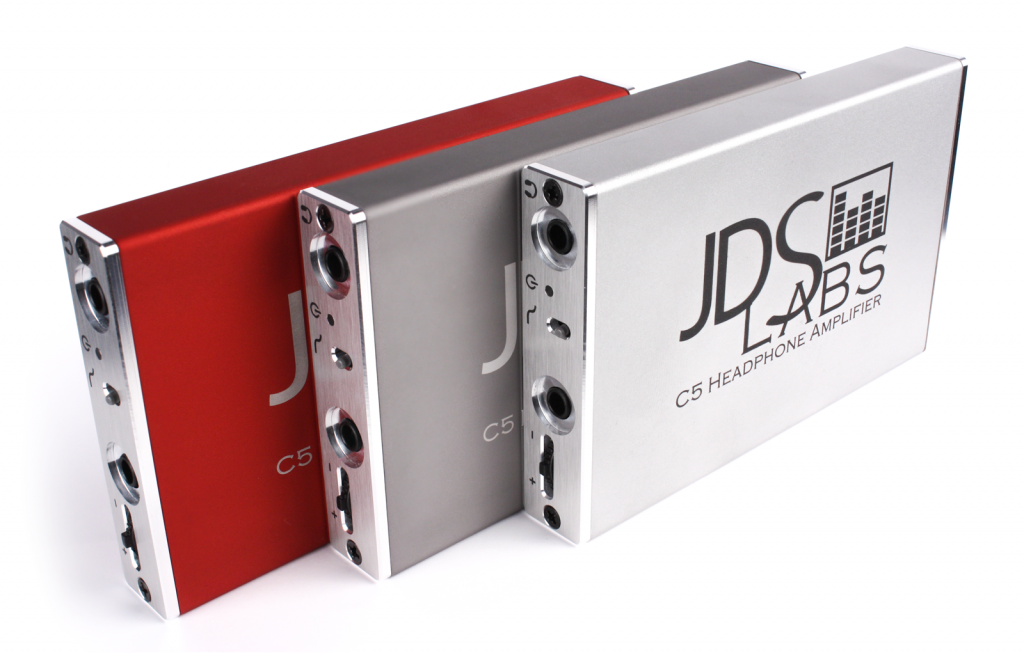
C5 Production Status
- Design: 100% complete
- Engineering Samples: Approved
- Benchmarks: 100% Complete
- PCB Assembly: 100% Complete, on a UPS truck
- Enclosures: In stock, awaiting anodizing February 19-22
Barring unforeseen catastrophic failures, C5 preorders will ship no later than February 28. Review samples and distributor orders will ship on February 22.
Wed., March 13 Update: The C5 preorder sold out this morning. Mass production began two weeks ago, so C5 will be in stock in just 2-4 weeks.
Tues., March 12 Update: 99% of preorders have shipped! New Slate C5’s ship immediately. New Red C5’s will ship next Tuesday, March 19.
Mon., March 11 Update: Slate anodizing remains on schedule for completion tomorrow morning. Our anodizer says this batch is turning out as desired.
Fri., March 8 Update: Over 75% of preorders have shipped (all Red and Silver). All Slate preorders are scheduled to ship by Tuesday evening.
Thurs., March 7 Update: We inspected and approved a new batch of enclosures today, and now expect to complete preorder shipments within 3 business days.
Tues., March 5 Update: We have encountered an “unforeseen catastrophic failure” as I wrote on February 16th. The enclosure delay mentioned last week was caused by our local metal finishing shop. Their job is to apply the smooth, blasted finish to C5 (bead blasting). As of last Tuesday, they realized they’d blasted our C5 cases with the wrong parameters. Already one week late, they called on 2/26 and promised to start over and deliver perfect pieces by Thursday, 2/28. All seemed fine, until we anodized those pieces. Our anodizer called this morning apologetically. His shop follows this blog and is well aware of the significance and beauty of C5. Every single piece from the “fixed” batch was not fixed. Anodizing had revealed severe cosmetic defects–all pieces from 2/28 were junk.
I drove to the blasting facility this afternoon and handed them two C5 enclosures: one from the first batch, and one from the 2/28 batch. The production manager was as shocked as we are, and will begin another batch in the morning with strict supervision.
It’s an absolute shame that one shop foiled our ambitions to ship early. As soon as we realized the possibility of failure, we began identical blasting production at a second metal finishing shop, for redundancy.
The Good News:
- We have a strong supply of raw enclosures; without delays, metal finishing normally takes just 2-5 business days.
- Over 61.5% of C5 preorders have already shipped
For those affected by the delay (mainly Silver and Slate preorders), we promise to upgrade all USPS First Class shipments to USPS Priority. Please do not hesitate to contact us if we can be more helpful!
Mon., March 4 Update: All Red C5’s have shipped. All outstanding preorders will ship by Wednesday.
Thurs., Feb 28 Update: Enclosure anodizing is in progress, and we still expect to ship on Monday afternoon.
Wed., Feb 27 Update: A large batch of C5 enclosures will enter anodizing by 1PM Thursday (a 1-2 day process). Preorders will resume shipping on Monday afternoon.
Tues., Feb 26 Update: Over 25% of C5 preorders have shipped. All PCBs have been tested and are awaiting final enclosure assembly. Our enclosure finishing contractors called this morning to report a 2-3 day delay, so remaining C5 orders will ship Feb 28 thru March 6.[/expand]
Design Priorities
C5 is not a response to the Objective2, nor to competitors’ products. C5 began as a fun project in 2012 to build a smarter headphone amplifier to solve the single greatest hindrance we see in DIY audio: the analog volume potentiometer.
C5 is built for portable users who need a small amp with USB recharging, exceptionally low noise, sufficient output power, long battery life, and most importantly, a super fine volume control to handle sensitive headphones and IEM’s.
Analog Potentiometers’ True Performance
I interviewed an electrical engineer in January. He’d applied here after discovering the Objective2, and during our discussion, he asked, “What’s there left to design? The O2 is audibly perfect. How can you build anything better than that?”
Easy, there’s no such thing as a perfect product. Every design has its unique goals and constraints.
Our Chinese competitor says the Alps RK097 analog pots are “still the best” solution, presumably based on low cost and decent benchmark performance. NwAvGuy dismissed digital potentiometers as too expensive to implement with good performance, while acknowledging the major shortfall of the Alps pot he settled on for the Objective2:
THE CHANNEL BALANCE PROBLEM: Devices with conventional volume controls may have audible channel imbalance at very low volumes [i.e., one side is much louder than the other –JDS]. It’s extremely difficult to manufacture volume control potentiometers that maintain tight channel balance below about -40 dB (referenced to full volume). — NwAvGuy
In this article he briefly describes how imbalance can be resolved with proper excess gain. The excess gain problem is primarily why we’ve custom built cMoyBBs for over five years. That is, setting a suitable gain usually avoids channel imbalance. Usually–until you’re sitting in a quiet room and want to listen at low volumes, or until you try a set of high efficiency headphones. Even at 1.0x gain, you’ll encounter major channel imbalance from your so-called high performance analog headphone amplifier in such situations.
Let’s take a look at channel balance of c421, measured by the dScope as I slowly turn the knob from maximum to minimum position:
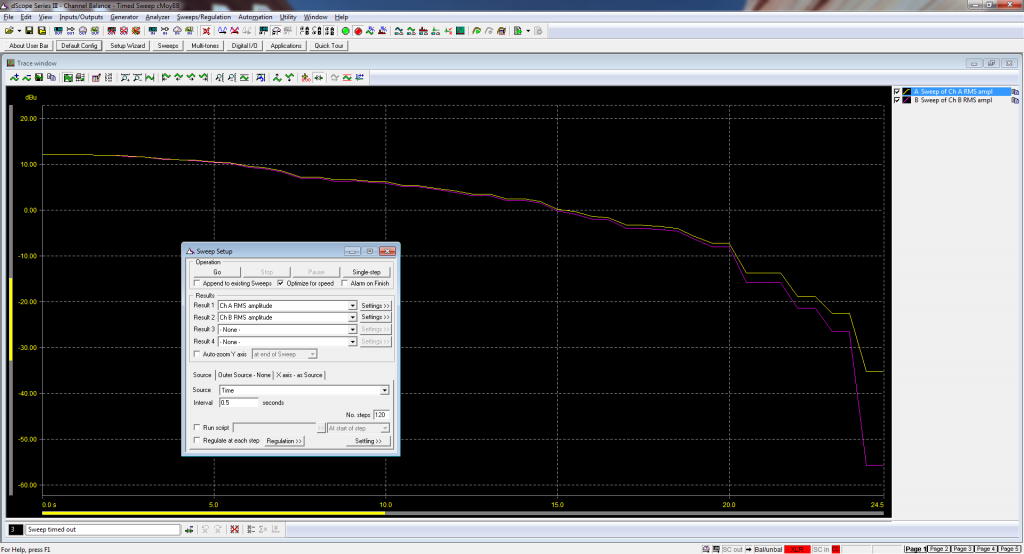
The yellow line represents the left channel; pink represents the right channel. Lines resting exactly on top of each other indicate audibly perfect balance (no deviation in L and R volume).
c421’s Alps RK10J imbalance grows after just -12dB. The problem becomes severe by -22dB, and it’s quite useless by -30dB. If you called or emailed in the past year, you know we didn’t recommended c421 for IEM’s. If you tried c421 without seeking our advice, you either listen above the imbalanced region, or you returned the product.
Here’s an Alps RK097 implemented in the cMoyBB (Objective2 uses the same series potentiometer):
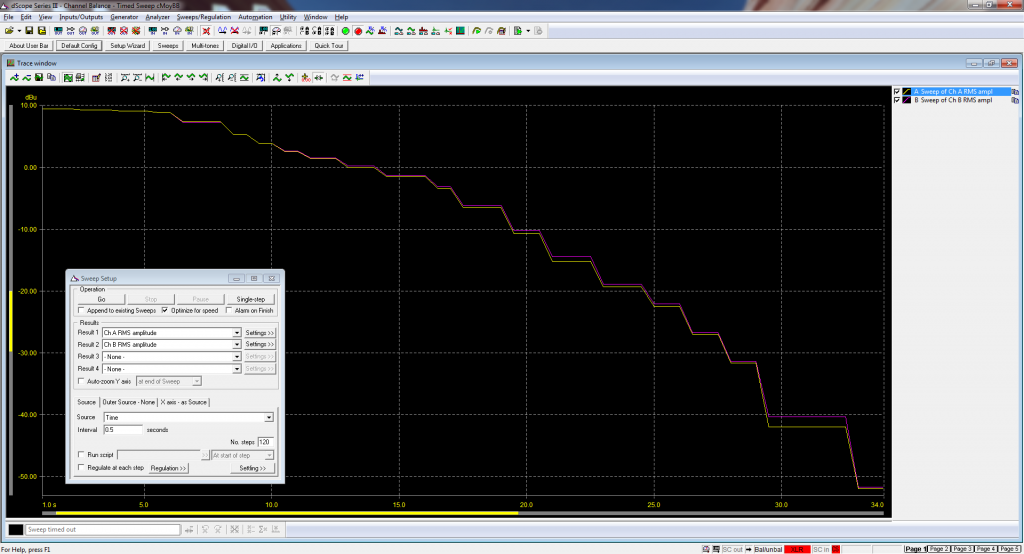
Channel balance of the RK097 fairs much better, due to its larger mechanical size. You can see 1-2dB deviations at -25dB, with otherwise decent balance down to -40 to -50dB. And that’s where things get nasty. I only managed to turn the knob at a single point when the dScope cycled to measure the imbalanced region, which is exactly the problem IEM users face. You can either turn the knob to mute, or to a point of imbalance, or to a level louder than you’d prefer.
Even with the RK097, we still receive a few emails and phone calls each month about channel imbalance. So what good is a HiFi amplifier when it actually hurts your listening experience?
Going Digital
For years, audiophiles feared digital volume controls. Software based digital volume control is the worst, causing you to “lose bits”–the audio signal itself is digitally divided and becomes less precise. Bad!
Early digital potentiometers solved the basic mechanical problems of analog potentiometers. A digital potentiometer is electrically equivalent to an analog potentiometer. Both feature High, Low, and Wiper terminals. The potentiometer is mechanically or digitally set to determine the ratio of High:Low resistance. However, bad digital pots added a large amount of capacitance to the Wiper, and thus, audiophiles frowned at the resulting THD+N (often 0.1% or worse).
It’s 2013, and it’s finally time to say goodbye to the analog potentiometer. C5 features 64 steps of audibly perfect digital attenuation:
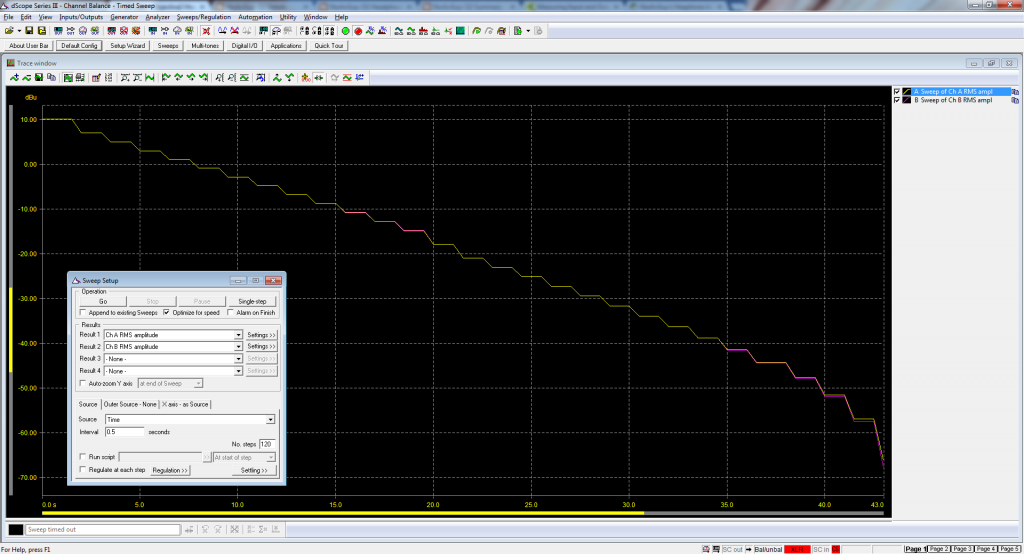
C5 presents only +/-0.1dB of deviation all the way down to -50dB, and only +/-0.55dB at -60dB! [Yes, you can only see 28 steps here, as I’m manually racing the dScope test duration by making larger volume transitions.]
In other words, C5’s digital attenuation achieves perfect audible balance at volumes -20dB lower than the analog Alps RK097. Remember that audio sounds twice as loud every 10dB, so this is no small improvement.
Reference Level Performance
C5 began as an experiment, and even I was skeptical that we could outmatch c421’s THD+N with a digital potentiometer. Thus, we bought a dScope III and set no project deadline and no budget. We’d either continue shipping c421’s, or continue experimenting.
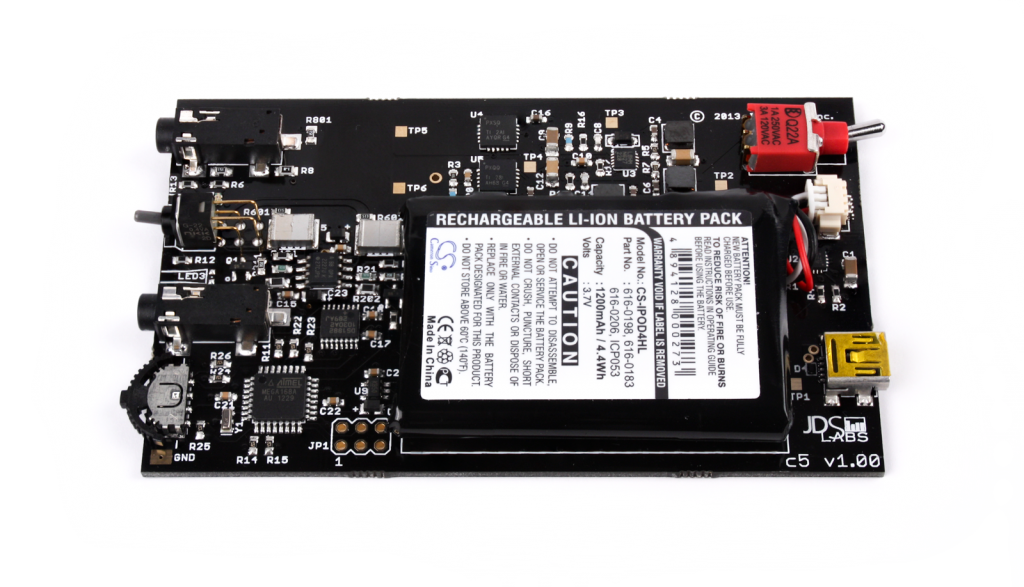
By January 2013, it was clear that C5 was electrically complete. We quietly put C5 PCB’s into production instead of another batch of c421’s. C5 had not only hit our THD+N goal, it had matched the O2!
| Specification | C5 Measurement |
| Frequency Response | +/- 0.02 dB |
| THD+N (20-20kHz, 150 Ω) | 0.0009% |
| THD+N (20-20kHz, 32 Ω) | 0.0045% |
| Noise | -105 dBu |
| Crosstalk @ 150 Ω | -67 dB |
| Inter-channel Phase @ 1kHz | +/- 0.01° |
| Channel Balance | +/- 0.55 dB, all volume positions |
| Max Output @ 600Ω | 4.146 VRMS |
| Max Output @ 150Ω | 3.337 VRMS |
| Max Output @ 32Ω | 1.010 VRMS |
| Power Supply | 14.0 Vpp |
| Output Impedance | 2.2 Ω |
| Battery Run Time | 11-14 Hours |
| Charge Time | 2 Hrs to 80%, < 4 Hrs to 100% |
| Operating Temp | –40°C to 85°C |
| Operating Humidity | 0 to 85% Rel. Humidity |
| Dimensions (excluding switches) | 99.5 x 61.5 x 14.0 mm (LxWxH) |
| Weight | 4.2 ounces |
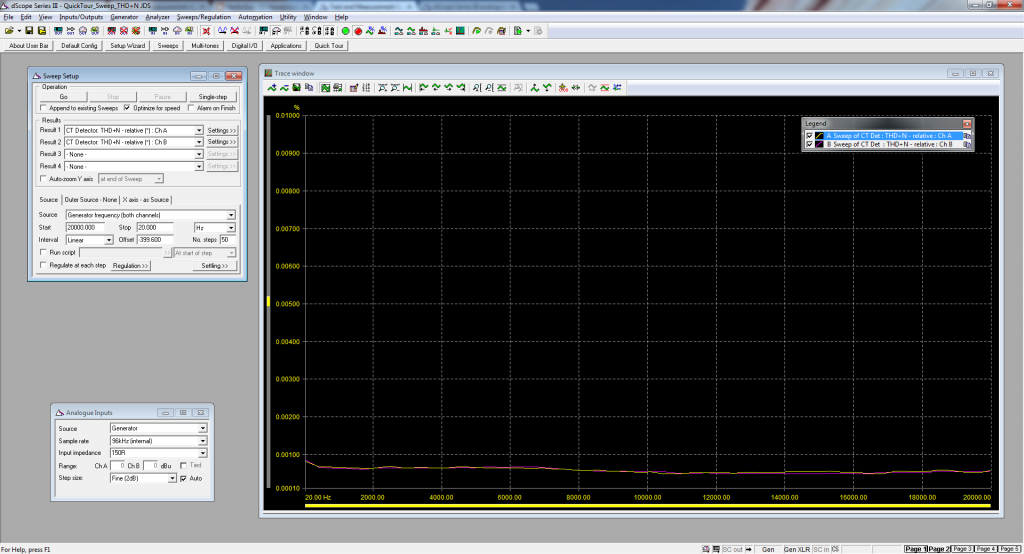
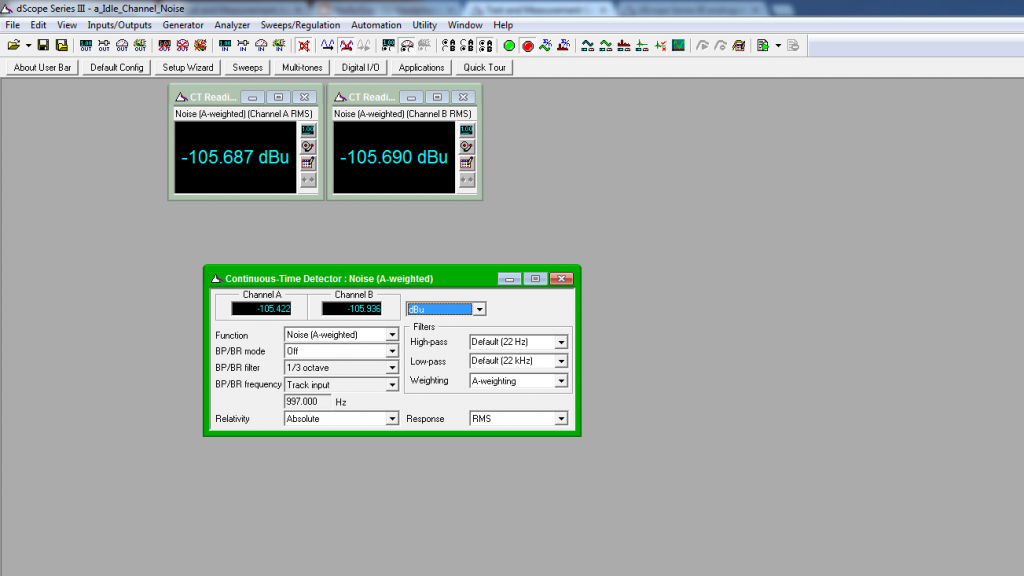
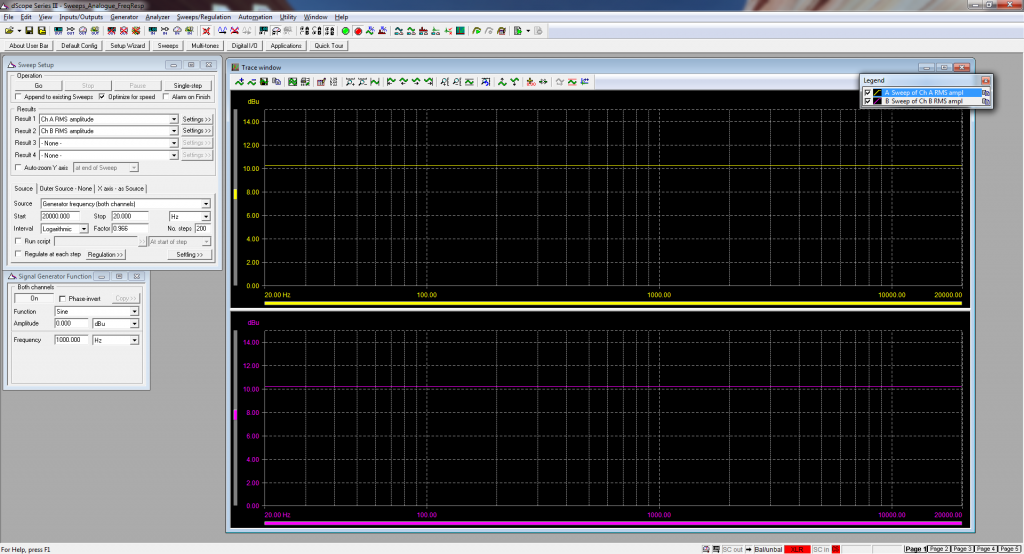
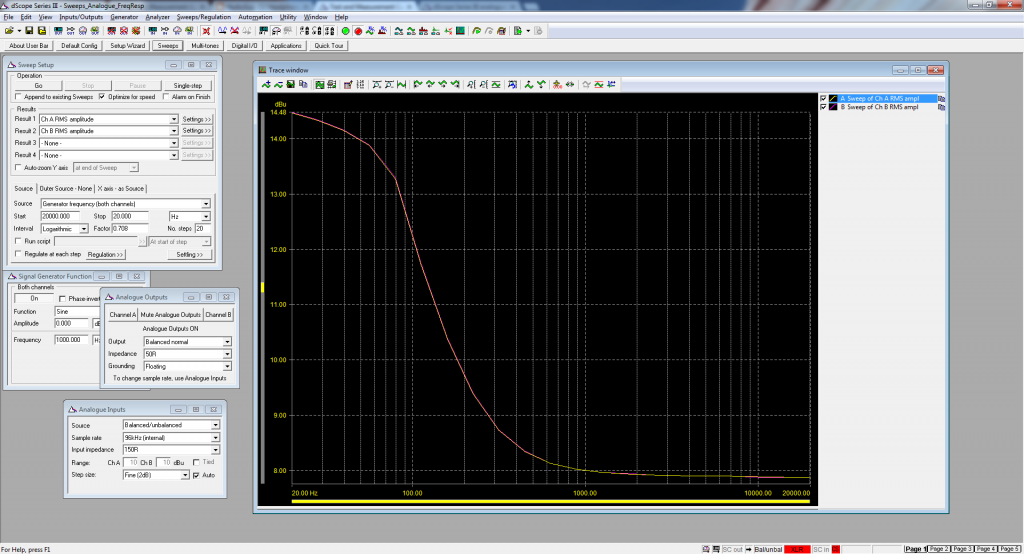
Achieving high output power was not a primary goal of C5. Referring to its design objectives, portable users do not need inordinate amounts of power (note: P = V^2/R); you need run-time and just enough power. C5 has equal output power to that of c421, and we know from measurements and subjective results that c421 and C5 are well suited to driving 90+ dB/mW headphones. IEMs and common 32-250 ohm dynamic sets are okay for C5. It’s not meant for your planar orthodynamics. Therefore, instead of setting unnecessary supply voltage and output power, we set adequate supply voltage for moderately demanding headphones and achieved run-time of 14 hours.
Dual LDO Supply Regulation
C5 builds upon c421’s proven power stage by adding cutting edge TPS7A4700 and TPS7A3301 regulators to the supply rails. Hats off to HiFiDuino’s blog post for catching my attention back in September.
We wanted to place LDO’s in c421, but there was no way to control them, and without control, unsynchronized LDO’s produce unsafe turn-on transients. C5 is smarter than c421, so its firmware simultaneously enables the positive and negative LDO’s after the rest of the amp has initialized. You hear only a safe turn-on transient with C5, and reap the benefits of ultra-low supply noise.
Features
- Digital Stepped Attenuation (63 steps + mute)
- Dual Gain: 2.3x or 6.5x, MOSFET controlled
- Bass Boost: +6.5dB @ 80Hz
- 20-Minute Low Battery Indication
- 0.1% Thin Film Resistors
- 1200mAh, 3.7V Li-Ion Battery
- Smart USB Charging
- Ultra Low Noise +/-7V rails
- 3.5mm Input and Output Jacks
- Gold Immersion, 4-Layer Printed Circuit Board
- Atmega168A MCU w/Opensource Arduino Firmware
| Feature | How to Use |
| Volume | Hold volume lever left to decrease volume, or right to increase volume. |
| Gain | Push volume control to toggle high/low |
| Bass Boost | Toggle up for normal audio, toggle down for bass boost |
A single LED conveys all of C5’s behaviors:
| Amplifier State | LED Status |
| Off | Off |
| On | Solid Green |
| Low Battery | Flashing Green |
| Charging | Blue |
Opensource Firmware

The C5 proof of concept began as an Arduino Pro with messy wires coupled to a c421: DIY style.
Writing firmware for a digital potentiometer is surely a hurdle for many in the DIY audio community. In pursuit of retiring analog potentiometers in DIY HiFi, we’re releasing C5’s firmware under the CC BY-SA 3.0 license. Note that a 6-pin header and ISP programmer are required to write to C5. Enjoy!
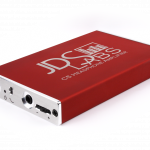
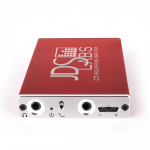
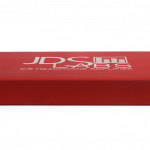
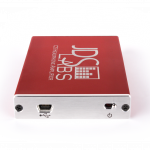
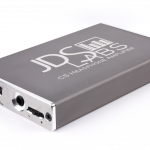
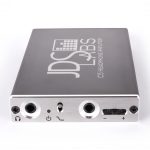
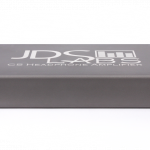
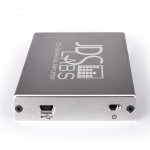
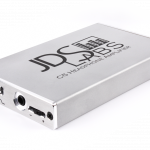
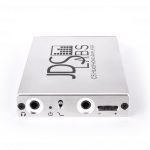
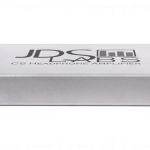
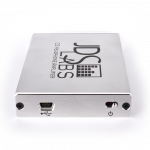
Awesome! I’ll definitely be getting one soon.
One thing I’m curious about that I don’t think you’ve mentioned — is it possible to listen to and charge at the same time? If so, does it affect battery health (i.e. using the battery even while charging, VS using USB directly), and does it increase noise?
I’m a software developer, I tend to listen to music all day long at work — it’d be nice to have something portable I can plug in without sacrificing the battery. Right now I’m using a PenguinAmp Royal + your ODAC.
Cory: Yes, you can listen to C5 while charging. Unless you have severe ground loop issues, there will be no audible noise while using USB power. The dual LDO’s do a fine job filtering out power supply fluctuations. I’ve spent hours listening from USB power and it works great.
First I’ll like to applaud your decision to design the C5 as a portable amp solely for sensitive iems and easy to drive headphones (though the C5 seems to be able to drive most headphones, just not the ridiculously hard to drive ones).
I just have a few quick questions.
(That’s because my eyes sorta glazed over when it came to the section where you published the C5’s measurements. I have no idea what they mean): Using a typical iem, will you say that the C5 is as sonically neutral as the O2 amp? I’m in the market looking for a neutral portable “O2” amp for iems.
When will the preorder ends and do you have a certain preorder limit for different colors?
Kite: Thank you! I debated whether to write so much technical data for a new product release. A discussion on our Facebook wall convinced me that at least some folks would appreciate the data. If not, the pictures do a great job!
Yes, C5 should be audibly indistinguishable from other neutral amplifiers such as O2.
The preorder ends either when we hit 250 orders, or February 28 (whichever comes first). There’s no limit on the # of colors. As noted at the very top of the article, we haven’t actually anodized any of the cases. The three photographed are samples from our anodizer. We’re using preorder data to determine the ideal number of each color to produce. We’ll have a decent idea by Tuesday 🙂
What about HD 580/600?
HD 580’s and HD-600’s will work great.
I’d be interested to see the THD+N spec at 32 Ohms and at 250 Ohms. The current reading at 150 Ohms is neither here nor there for the impedance that the amp will see in the real world, seeing that most cans are either north or south of 150 Ohm by at least 100 Ohms. I reckon the spec won’t change much, if at all at 250 Ohm, but it will budge at 32 Ohm. Cheers.
Agreed. The dScope has 150 ohm and 600 ohm input stages (baffling…). I’d prefer 32 ohm measurements as well. I’m seeking a solution.
A reading at 600 ohm will do, thanks. We can then simply interpolate–assuming linear change–from that reading and the one at 150 ohm. Cheers.
Output at 150 and 600 ohms should be in the specs already 🙂
I was talking about the THD+N spec.
Ah, that can be arranged
Not sure if I missed it but I don’t see the physical measurements or weight. Any chance you can provide those along with pictures say with a dac, dollar bill and/or headphones? I can guess at the size but sometimes it’s nice to have something to compare against.
Just found the dimensions. Pictures would still be nice. Thanks.
Weight added (4.2 oz). Good idea, we’ll add reference objects pictures soon.
Would you recommend using the C5 for a modded T50RP (e.g. MrSpeakers’ Mad Dog)?
#–#
Btw,
“Bass Boost Toggle up for normal audio, toggle down for bass boost”
Should be the other way round, right?
“Bass Boost Toggle up for normal audio, toggle down for bass boost”
That’s correct; the typo was in the instructions PDF (now concurs).
Your T50RP’s are 97db/mW @ 50 ohms. Yes, C5 can drive these fine.
what’s the benefit of preordering vs waiting -e.g., till end of march?
Preordering guarantees a quick ship date. It’s possible that demand will outpace initial production.
okay. works for me. order submitted.
Great to see another company publishing measurements; that said, if you’re going to argue for the transparency of your amplifier based on said measurements, voltages used (where applicable) and LF/HF IMD tests + THD sweeps into lots of loads (the latter as mentioned above) would be nice 😀
Willakan: I couldn’t agree more. We’ve only had a few [busy] weeks with the dScope and haven’t devised a test apparatus for additional impedance loads. The dScope uses 150 and 600 ohm internal loads, so extra physical work is required to test at other impedances. You’d think it would easier with a $10k machine!
The only other thing that might be interesting, IMHO, is how the distortion performance of the amplifier alters when you use the digital volume control to reduce volume by, say, 10db, (the argued advantage of an amp using analog attenuation being the absence of a significant difference) but as you say, all in good time!
Willakan: Right, distortion will change with volume. I briefly tested this and observed nothing alarming. The DS1882 is conservatively rated better than 0.005% THD+N at all attenuations. We’ll follow-up with additional sweeps and load tests after knocking out these preorders.
Looks like you have built a worthy 421 successor. Considering placing an order, as I travel a lot and would love to have a great amp with me at all times. I listen a lot with my Klipsch Image X10 in ear headphones, which are rated at 50 ohms and a sensitivity of 110 dB SPL/mW (1 mW). I also listen to a pair of Klipsch Custom-3’s rated at 32 ohms and 115 dB SPL/mW (1 mW). Based on your notes above, it seems like a safe assumption that the C5 is a good match for headphones like these Klipsch. Can you confirm? It would be great to use these at home on my Sennheiser 650’s until I purchase a full size amp, so can you tell me how these pair with the 300 ohm 650’s? Thanks in advance for your responses.
Ray: Correct, C5 is well suited for all of your headphones. Your HD-650’s are 103dB/mW @ 300 ohms, so they need about 16mW. C5 delivers 28mW into 600 ohms. This means it will provide more than twice the necessary power into HD-650’s.
Thanks for the quick reply. One other question. It just dawned on me that there is no gain switch. So does this mean the amp automatically adjusts to the load of the headphone? Very sharp by the way, and I like the new colors.
Gain is toggled by pressing the volume control forward.
hi, very intrested in that amp
Would it be valuable for use with Westone UM3x (intra) or only worth with “big” headphones (not intra) ?
I’m feeling lack of power and clarity at high level with my actual ipod.
Thanks for the advice !
Nat: UM3x are exactly the type of headphones we intended for C5 (high sensitivity, low impedance). Yes, C5 should help you.
Hello All,
I am very interested in making the C5 my first and only headphone amp. I just purchased the V Moda M100’s and am wondering if this amp will be appropriately matched to them (below are the specs for the M100).
•Sensitivity: 103 dB @ 1kHz 1mW
•Microphone Sensitivity: -42dB @ 1kHz
•Impedance: 32Ω
Thanks for any/all help with this inquiry.
Angel: 103dB/mW @ 32 ohms is no problem for C5.
“C5 are well suited to driving 90+ dB/mW headphones. IEMs and common 32-250 ohm dynamic sets are okay for C5. It’s not meant for your planar orthodynamics.”
The impedance and sensitivity of the planar magnetic / orthodynamic HiFiMAN HE-400 and HE-500 headphones are 92.5 and 89 dB/mW respectively, and 35 and 38 Ohms.
What is it about these planar magnetic / orthodynamic headphones that makes them a poor match for the C5?
What would be the performance drawbacks if the C5 were used with these models, or other orthodynamics (such as the HE-6 that is MUCH more power hungry, or the Audeze LCD-2/3)?
Is the C5 totally unusable, or acceptable with caveats, when paired with orthodynamics?
Jeff: Good question. I should’ve elaborated on that generalization. A sensitivity rating is useless without reference to impedance. Most low sensitivity headphones have a moderate or high impedance. C5 has no problem with low sensitivity, high impedance sets. C5’s specifications also make it suitable for lower impedance but higher sensitivity sets, like Grados and most IEM’s.
Planar magnetics tend to have very low sensitivity as well as low impedance. So they demand considerably more power than other types of headphones. If you have time, read through this article for more insight.
No, C5 is not totally unusable with LCD 2’s, etc. You can still use the amp; maximum output is the only limitation. Orthos are best paired with a suitably powerful amp, like O2.
Very interesting looking amp. Would the C5 work with Shure SE215, Sennheiser Momentums and AKG K550? Is shipping to the UK available?
Broken: All headphones you mentioned are within C5’s output power capability. We ship worldwide.
May I know how this C5 compare with the C421 in sound quality ? Is it worth to upgrade from C421 ?
From what I get it does solve the imbalance at lower volume but since I used the headphone normally I set to a medium volume on my C421.
kupleh: c421 exhibited slight bass roll-off and higher output-impedance. C5 sounds fuller, with more natural response. You’ll have to wait for reviews for a detailed answer 🙂
Is C5 going ALL black like my current c421? 🙂
Carlo: For now, no black. Individual cases for C5 will be available in our store after the preorder (easy to change colors later).
is this compatible with the audio technica w3000 anv?
MKM: Yes
Will the c5 be able to drive low impedance/high sensitivity earphones without hiss/buzz?
Do you happen to have output voltages at 8 and 16ohms?
Bob: C5’s noise floor of -105dBu should be inaudible. Audible hiss typically comes from the source. To keep source hiss low, you need to supply the amp with the strongest signal your source can output (ideally, line-level). Note that even an “ideal” amplifier with an infinitely quiet noise floor will magnify source hiss as soon as output exceeds unity gain. In other words, keep source volume high, amplifier volume low.
Paul: Q- and K-701/702’s are well within C5’s output capability.
How’s the c5 with k701/702 or q701?
Sensitivity 105 dB/V
Rated impedance 62 ohms
Max. input power 200 mW
The plethora of queries about whethe the C5 can power this or that headphone, I think, is due the propagation of this idea–one that is much overstated and misundertood–that matching of an amp to a pair of headphones is a delicate science that borders on art. It is not. As I posted on the FB JDS Labs page, in an solid-state amplifier as clean and neutral–in the objective, measurement-based meaning of the term–as the C5 the only reason to not pair it with a given set of cans turns on two issues: insufficient power and impedance mismatch. The only cans that are not well suited to the C5 are those with low sensitivity and low impedance (read, orthodynamics), and those whose impedance approach the output impedance of the C5, 2 Ohms. Everything else should be fine.
I’m in agonies here. This is so very tempting! Anodized instead of brushed AL, low output impedance, step attenuation, better LED placement! Everything a C421 owner ever hoped for is in this baby. I’m still in love with my C421 and don’t want it to be thrown to the wayside when I choose to get this amp. But looking at the measurements and specs, the C5 just seems better all around. Since an all black option is still unavailable I will have some time to mull over this some more. Good work on the outward improvements though Mr. Seaber. Can’t wait till I can get a listen.
You can keep your C421 as a spare amp, or start your collection of amps, just like many people display their old cameras as discussion pieces and decoration in their living room.
What opamp does the C5 use? still the 2227?
Congrats on this feat of engineering! I still love my c421, I can only notice the channel imbalance with my ear buds, but I usually listen at a relatively high volume anyway so its completely tolerable for me. Its becoming my favorite amp for my T70, especially since I got it custom installed with an AD823A chip which makes its nice and warm like I like.
Mark: Yes, OPA2227. It’s a strong performer and continues to review well. Someone will probably rehash the opamp discussion, so here’s a series of emails from Monday:
Are you still on track to ship the pre-orders no later than the 28th? Mine will have to travel very, very far from the Midwest so the sooner you ship, the better…
Tamalito: Yep, right on schedule. UPS delivered the entire batch of assembled C5 boards late this afternoon–flawless. We shipped 11% of preorders by 7PM this evening, and expect to fill all preorders by February 28th as promised.
We’re shipping Red C5’s first, and a few Slates. Our anodizer will have a large batch of Silver and Slate cases ready for us by Tuesday.
C5 preorders sold 4x faster than we planned, so we’ve already begun another round of PCB production. We’re all working overtime to stay ahead.
Great, though I am still waiting for the shipping confirmation on my preorder of my red unit placed not long after the preorder period began.
JDS Labs got in touch with me via email to explain the hold-up. I had forgotten about some special requests in my order, and this explains the delay. My bad. Keep up the great customer communication and service!
This is kind of irrelevant to the C5 itself, but if I own an iPhone, would your recommend using the FiiO L3 line out dock connector, or their L9? I was thinking of getting the L9 but the cable might get in the way of the volume lever.
Have you tested it with any multi armature BA IEM’s with crossovers? Was the FR response also flat with them?
Thx.
btw, visually it is sweeeeet looking amp.
glassmoon: Consistent output from one headphone to the next is a matter of output impedance. C5’s output-Z is 2 ohms, so it should be paired with 16+ ohm headphones to ensure flat response.
I hope this is not the post that starts a flame, but I was simply wondering: have you tried to do a blind comparison between the O2 and the C5? I guess someone could be interested in the results…
Marco: We leave A/B comparisons and testing to reviewers and customers.
I understand. It’s just that I don’t expect so many blind comparisons from reviewers. Perhaps, would you care to share your opinion in private?
What is the status of the pre-orders? Have they all been shipped?
Av.ator: The latest status can be found above. We’ll post another update as soon as every order has shipped.
initial impressons of c5…
i received my red c5 almost ten days ago. so, given that it’s my first portable headphone amp, i have no real basis to compare to other portables. i initially planned to purchase the $30 fiio e6, then fiio e11, then jdslab c241 and then after contacting mr seaber, i decided to wait for c5. i do have an audioquest dragonfly dac that use with laptop while traveling or at the office. and i have a benchmark dac1 that contains an excellent headphone amp. given the design constraints of c5, like power supply and size, c5 does not complete with benchmark. the benchmark noticeably outperforms in energy, pace, rhythm, dynamics, noise/blackness and more. c5 will not replace dragonfly dac. i use that everyday in the office with shure se535.
i bought c5 for use with my phone and mp3 players while traveling on planes, in hotel rooms with portable speakers (jbl ontour) and car rides. i spend more time on planes and hotel rooms than at home. in the past ten days i have used the c5 in all these settings. and i feel quite pleased with the sound quality and most of the design -more on that.
i like the volume control much more than i expected. in fact, unexpectedly, i prefer it to rotary control and push buttons. before listening, i let the c5 burn for about 20 hours by plugging larger headphones and letting music play continously -still doing that when home. compared to listening without c5, i immediately noticed the quantity, richness and effortlessness of the bass -and that’s without bass boost. the upper frequencies sound smoother too -less fatiguing. definitely made a huge difference with my verizon google galaxy nexus phone. in the car, i use my phone to stream music from my home computer via subsonic. all music is lossless flac. again, much more enjoyable with c5 than without. richer, smoother, more dynamic. the build quality looks outstanding and the design well-thought and quite attractive. it’s smaller than both my mp3 player -a highly customized toshiba gigabeat running rockbox and solid state drive- and mobile phone. i love ability to listen and charge. love that it charges via mini usb. i make my own battery external power supplies that use aa or aaa batteries. the jbl ontours speakers play much louder and richer. definitely more likely to get complaints from other hotel guests now. overall, i feel quite pleased with c5. again, it’s my first portable headphone. i consider myself an audiophile. that means i love listening to music -mostly vinyl at home and that my main music system costs more than my “luxury” european car.
the least desirable quality of c5:
now the rant… this is likely a personal preference. the anodized finish is rough and my skin crawls when i touch it. i tried buffing with only oil, wax, pvc pipe and nothing helped. i can understand the reason that i very rarely notice products with this sought of finish. i really, really have yet to appreciate it. if i walked in store and picked up the c5, i wouldn’t even listen to it. i feel so strongly about this that it crosses my mind everytime i think of touching the c5. mr seaber, if choosing this finish saved money, i question the decision. if you please offer a case with a smooth finish, i shall replace mine. or tell me how i can smooth the finish. i’d consider taking it to metal shop. it bothers me that much. again, likely personal -like scratching fingernails on a chalkboard. now that i own c5, would i return it for this reason or do i regret purchasing it? absolutely not. even with undesirable finish, i’d buy again. perhaps, had i experienced other portable headphone amps, my opinion may differ.
so, for someone who places a high value on the quality of music reproduction, does the c5 enhance enjoyment of music? most definitely. what’s that worth to me? at least $189. for others, a fine bottle of wine mean more. sure glad i waited for c5. thank you, john.
Hi John,
In anwer to the above review, all the person has to do is buy a skin from Zagg and the problem of this objection to the finish is solved.!
I have the red version and I think it is terrific and the finish great.
The sound is incredible for this little rascal and the controls very good. Well thought out.
Regards,
Les.
Hi again,
Just an addition re: a Zagg skin. It would be a Zagg invisible shield film, to be 100% correct.
Regards,
Les.
thank you, les.
Do you have a future product in mind that combines the C5 with a built in ODAC? All my sources are digital at this point; so that would eliminate the wide variety of DAC I deal with from device to device.
Willy Wonka.
you mentioned you would use your dragonfly over the c5.
I am new to all this. I purchased an se535 IEM to use with my creative zen vision m.
I have been thinking of getting a dragonfly to use with my old dell laptop (music on a thumb
drive saved as 320 mp3s).
But then i thought…if i get the c5, i can use it with BOTH mp3 player AND laptop.
Which sounds better…the c5 or dragonfly?
Dragonfly is a DAC, not an amp. So comparing the two devices is an apples/oranges discussion.
mike:
john’s right. definitely not a exactly a fair comparison. that said, your timing’s perfect because at this very moment i’m actually using bought the dragonfly and c5 right with my laptop and performing comparisons. i tested the following configurations:
1.) headphone out from laptop (dell latitude e4310) to c5 to shure se535
2.) dragonfly (df) out to se535
3.) dragonfly to c5 to se535
i didn’t bother testing just from computer headphone out. i already know the c5 and dragonfly soundly best the computer’s out.
results:
1.) computer out to c5 to earphone:
noisy. with no signal playing, c5 amplifies the noise from the computer’s out. with music, the noise seems imperceptible. seems. definitely waaay more enjoyable with c5. if only heard c5, i’d feel quite pleased with the vast improvement. more dynamic. more space. wider soundstage. more slam. more bass -better defined and controlled too. more body to bass and entire sound. more musical. less fatiguing upper frequencies. this setup seems to work well. i could stop here. only annoyance is background noise with music paused or stopped. decide to test how charging c5 may affect noise. charging from computer’s usb definitely exacerbates. charging from ac minimally increase noise. overall, save for when paused or stopped, quite enjoyable.
2.) dragonfly (df) to se535:
silence. not quite. really quiet though. after noisy experience with computer out and c5, i immediately notice the silence of the df. with music playing, blackness of the music’s background seems to counter the seeming imperceptibleness of the computer/c5 combo. df sounds noticeably smoother from top to bottom. hmmm… the “s” sounds seem more pronounced. overall, a great little dac and headphone amp. i’ve only ever used with iem like se535, so not sure how amp would work with more demanding headphones. the size of df played an important decision to purchase.
3.) df to c5 to se535
a smidge more noise. c5 imparts some noise with nothing connected to it. nothing that detracts from my enjoyment. music seems more energetic. more bass. more three dimension. less fatigue. smoother. i feel more motivated to play the music louder with c5. this aligns with my experience when using c5 with phone and mp3 player. a/b comparisons indicate that with c5, those “s” become less emphasized making music sounder less harsh and thus, inviting me to turn the volume up. john perhaps equalized c5 to rolloff the highest frequencies creating more “warmth”? again, c5 seems to add more slam. i feel more compelled to dance. i feel like i hear more into the music -like i notice more detail. real or imagined?? save the noise, all my other comments about c5 in scenario #1 apply here. this combo even makes pandora more enjoyable -though still harsher than flac files/streaming. also, charging via computer’s usb is still very noisy. when charging via ac, i struggle to notice any difference in noise.
so, obviously, it seems the best combo is a high quality dac combined with high quality amp -probably like jds’s o2+odac. customer application imposes design constraints. though i expect the o2+odac sounds fantastic, it seems impractical for my purpose -portability. the df is perfect for what it does. if i already owned c5, i’d still buy df. i want an uber portable dac/amp. for travel and office use. i also use to connect computer to home stereo for sampling music on spotify and listening to webinars/web conferences.
other thoughts:
i love the volume control on c5. offers easy one finger operation. i’ve only used bass boost with portable speakers. definitely unnecessary. another observation: i have a pair of ultimate ears 600 earphones that i keep in the car. i’ve never quite enjoyed these monitors. plugging the ue 600s into c5 revealed that these iem offer surprisingly enjoyable performance -especially for the money. though, i still feel less than enthused about the feel c5’s anodized case, the case has grown on me. i definitely appreciate how the red finish looks. very attractive piece of equipment. also, from attempting to smoothen finish via various potentially harsh methods, i can i attest to the durability of the anodized finish. despite my efforts, the finish remains unmarred. i even appreciate the graphic on c5. i typically prefer minimalist appearances.
bottom line:
if you forced me to pick one device, i expect that i’d pick the c5. it offers more utility for me. i can use with my mp3 player, mobile and computer. the noise from computer/c5 combo would likely push me to buy a dac -like df. music through the c5 is just more enjoyable. c5 rocks. once i begin listening to music through it, i find it a challenge to stop. i also find that i want to really listen to the music. i.e., i want to stop doing and just listen -staring blank out the window in the office or on the plane. it’s so damn enjoyable. again, well done, mr seaber.
btw, fwiw, the source setup:
i store about a 1tb of lossless music (95% flac, 5% ape and wav) on two dislocated, 2tb, redundant/synchronized fireproof, waterproof and disaster proof external hard drives each tethered to separate desktops running ubuntu linux. i’ve spent about two years ripping over 2k albums and downloading or scanning image files.
i installed subsonic on both and use subsonic on my phone and subsonic web client on my computer. on my windows computer, I use subsonic web client and stream music via foobar2000. this allows me use foobar’s extensive dsp configuration options. through foobar, i use the resampler dsp component and upsample the lossless files to 192khz. use reverb component and add a some minor reverb. on the phone I use no dsp. fortunately, I have a grandfathered unlimited data plan because some months i’ve streamed over 50gb via the 4g connection on the phone. lossless files are big. when I lack adequate bandwidth, I will stream pandora –also often do so while driving. while traveling on planes and airports and exercising, i listen via tweaked toshiba gigabeat mp3 player running rockbox.
this setup has already saved me twice when hard drives or software corruption required me to reload from one server to the other. actually, thought of adding a third drive in another completely different state. until someone offers a lossless music service that functions like spotify or rhapsody this is how i roll.
Interesting amp! A couple of questions…
What is the typical output DC offset voltage with the inputs grounded?
Would you post a FFT of the output that extends through whatever the DC-DC converter(s) frequencies are at? I’m curious how much of the converter frequency makes its way into the audio. I’m sure there will be some, just curious to what extent.
I would agree, pretty important to find a way to measure the specs at 32R – 40R. A lot of phones have that Z these days it seems.
I probably just missed it in the specs but what is the charge time? Guessing 1200mAhr / 450mA (USB) = somewhere around 3 hours.
Thanks. 🙂
Hello All,
I am thoroughly enjoying the C5 and the stratospheric level of customer service associated with JDS Labs! I am writing/inquiring as to whether or not there are any reviews of the C5 paired with the ODAC? I am a newcomer to Hi-Fi audio and the C5 is the first portable amp I have ever owned. My setup is a Ipod 5th Gen 5.5 Enhanced>Fiio L3 LOD>C5 Amp>VModa Crossfades M100. Apart from switching out the Ipod LOD or Headphones can even more phenomanal sound be had with the introduction of the ODAC for my current portable “rig”?
I’m a fellow iDevice+L3+C5+M-100 user as well! 🙂
The ODAC only connects to a source via USB and since it’s not Apple Certified, it won’t work with an iDevice. Apple Certified DACs cost a fortune (in my opinion) so the best you can do is bypass the iDevice’s internal audio amp with a line-out connection like with the L3.
That being said, I do own and use the ODAC with the C5 connected to my computer/laptops and I really like the sound it outputs. Instruments are much crisper and better-defined, the soundstage opens up a bit, and the level of resolution just improves overall from the stock internal soundcards. If you consider a laptop+ODAC+C5+M-100’s a portable rig, then you’ve got a pretty great-sounding portable rig!
^ I load only ALAC music files to the Ipod so that I try to get the most detail out of my C5 (which it does ever so effortlessly with vibrance/clarity).
Is there any feedback about the c5 with the beyerdynamic dt770le?
Although I like my O2 with the le’s I find it not so portable.
The ideal would be if the c5 could give some more mid presence to the LEs.
Hi,
Just wondering how mass production is going and if back orders will start shipping on time. I am a robot and need my amp. Take me to your leader.
Thx
Justin: Going smoothly! We approved production samples on Monday. Red C5’s will ship April 10-12. Slate cases will arrive last, just in time to ship by April 12.
Is it possible to use a setup such as;
iPad>cck>dac>C5
and bypass the iPad’s internal dac in this manner assuming you are using a powered hub for the dac?
OMGITSME: Yes, you can stream digital audio from iPad with a Camera Connection Kit (CCK).
Looks like you really put an objective attitude on this design. I like it! I will get one anyway.
Hi
I have some doubts that Lithium battery will survive over temperature range from -40 to +85
Hi,
I wonder if C5 would be a good choise for using with B&W P5 headphones? I need your advise, thanks.
Sinan,
Yes, P5’s have a sensitivity of 115dB/mW @ 27 ohms. This means they require 1mW to reach 115dB, which is considered painfully loud.
C5 provides substantially more than 1mW. Its superb noise floor, THD, and precision volume control will all be a great match.
–JDS
How would the c5 pair up with my iphone and a pair of urbanears?(zinkens)? im new to audiophilia…
Tim: Your Urbanears Zinkens are 85 ohms @ 98 dB/mW, with a maximum input power rating of 50mW (pretty unusual specifications, by the way).
C5 will drive your headphones well in conjunction with your iPhone.